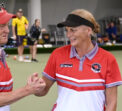Lawman – The Chestnut Edition
Yet another successful Pennant and State event season has ended so it is timely to now recall some of the the most common questions that arose, and issues brought to Bowls Victoria, Officiating and Laws Committee by umpires and bowlers across the State. Chestnuts, I see in our fruit shops, are in Season now!

YE OLDE CHESTNUTS
Playing out of turn:
What happens if players play out of turn?
Playing out of turn is part of the Section 2 – Game Anomalies, Law 29, Irregularities during play.
Law 29.1 states the opposing skip can stop the bowl and return it to the correct player.
Law 29.2 states that if the bowl comes to rest and does not disturb the head, the opposing skip must decide whether to leave the head as it is and have their team play two bowls to re-establish the correct order or return the bowl and to get back into the correct order.
Law 29.1.3 covers the situation if the head has been disturbed by the bowl the opposing skip can either:
- Leave the disturbed head and have their team play two bowls to restore the correct order.
- Replace the head to its former position.
- Declare the end dead.
Law 29.1.4 (a recent edition to the Laws) states that if a bowl has been played by each team (or player in Singles) before its realised they are out of turn, that end only must continue in that order.
Score cards don’t match in Pennant:
DR3.1 states that in Domestic Play in Australia a scoreboard cannot be used in instead of a scorecard. The scoreboard can be updated at any time by any player but must be updated at least every second end, (DR 3.1.1). The second is responsible for the accuracy of the scoreboard. Note, there should be numerals or symbols in ALL boxes on the score card, (Page 31, BA Officiating Manual), this assists finding any errors much easier.
DR 3.2.4 states that in Fours the second from each team shall carry the card.
So, what happens if the Seconds don’t agree?
The Seconds need to compare scorecards to establish when they both last agreed. It should not be more than two ends as the seconds should be concurring at the conclusion of each end. However, if they cannot agree they should consult their skips, if still no agreement call the Umpire.
An umpire should try to sort the score card out with the seconds going back to where the error was made. If no agreement can be made, then take the score on the scoreboard and whichever score card matched the scoreboard would be taken as the correct score.
Apart from completing and comparing scorecards at the completion of each end (which should happen) the seconds are also responsible for checking that the scorecard matches the scoreboard. So, the scoreboard in this case should be used to assist the umpire in deciding the correct score. The umpire’s decision is final.
Placing the mat and jack at the commencement of an end:
Scenario A: The mat has not been placed on the centre line and the jack has been delivered, centred and several bowls have been delivered.
Law 6.2.3 clarifies this situation stating that if the mat is off the centre line, (and at any time during the game) it must be moved to that line.
Scenario B: The jack has not been centred according to Law 6.1.1 and a bowl has been delivered.
Law 9.7 states that after the first player has delivered the first bowl, no-one has the right to challenge the legality of the original position of the jack. Therefore, the jack must remain in the incorrect position for that end.
Colour of the jack:
The jack must be solid sphere (ball shaped) and either yellow or white. (Law 51.1)
The red jack in BPL Competitions is by arrangement and approval.
In social bowls you can use any jacks, colours, or decorations.
If a player is approved by (the National Governing Body) as blind or sight impaired and they can only see a particular colour (either white or yellow) they can play with a different colour jack to that of the other rinks. Covered by Law 41.3. A visiting club would need to inform the home club prior to the day. Side managers would need to communicate this information.
Other issues to consider and ponder:
- The jack is called a jack in the law Book, there are no kittys in bowls or the Law book.
- Players do not have to stand on the bank when umpires are measuring. Players do need to ensure they are not interfering with the measure. E.g. casting shadows, standing too close.
- The appointed umpire of the day can measure a disputed shot on their own rink.
- Markers should avoid standing on the bank when marking.
- A player must not deliver their bowl until their opponents bowl has come to rest. (Law 13.3). There are penalties. (Laws 13.4.1 and 13.4.2)
- If the Laws are silent on an issue, then you cannot assume that you can do it.
- A declared ‘dead end’ does not have to be replayed in the same direction. (Law 20.2)
- You can only receive advice from a coach when a team or side is in possession of the rink and from only from the outside the boundaries of the green. (Laws 44.3 and 44.4) Coaches in a side game cannot coach from on the green.
- When measuring whether a jack is legal in length of delivery, the measurement is from front of the jack and the centre line of the front of the mat.
- In Pennant, when a team has completed their trial ends, they can start their game, you are not required to wait for all teams to finish their trial ends to commence.
- A player must not go into the neighbouring rink where play is in progress. (Law 12.2.1)
- When using trammels always remember that the larger end of the trammel goes to the (larger object) – the bowl.
THE LAWMAN
John Roberts
Co-Chairman
Officiating and Laws Committee




